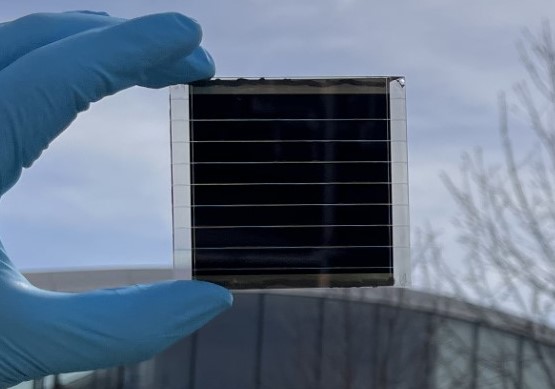An international group of scientists led by the Ecole Polytechnique Fédérale de Lausanne (EPFL) in Switzerland has developed a solar panel relying on the record-breaking 25.32%-efficient 2D/3D perovskite solar cells it unveiled in July 2023.
“Our new research demonstrates a larger surface area of 27.22 cm2, achieving an impressive efficiency of 23.3%,” the research's lead author, Mohammad Khaja Nazeeruddin, told pv magazine. “This brings us one step closer to the commercialization of this groundbreaking technology and marks a significant advancement in perovskite solar cells.”
In the paper “Dopant-additive synergism enhances perovskite solar modules,” published in nature, Nazeeruddin and his colleagues explained that the module's high efficiency was achieved thanks to a synergistic dopant-additive combination strategy aimed to improve the cell absorber's uniformity and crystallinity. They used, in particular, methylammonium chloride (MACl) as a dopant and a Lewis-basic ionic liquid known as 1,3-bis(cyanomethyl)imidazolium chloride ([Bcmim]Cl) as an additive.
“This strategy effectively inhibits the degradation of the perovskite precursor solution (PPS), suppresses the aggregation of MACl and results in phase-homogeneous and stable perovskite films with high crystallinity and fewer defects,” the research team stated.
The panel utilizes a cell with a substrate made of tin oxide (FTO), an electron transport layer made of titanium oxide (TiO2) and tin(IV) oxide (SnO2), a 3D perovskite layer, a 2D perovskite layer, a spiro-OMeTAD hole transport layer, and a metal contact based on gold (Au). The cell uses a 2D perovskite layer at the interface between the perovskite and the hole transport layer, which the researchers said can improve charge-carrier transport/extraction while suppressing ion migration.
Popular content
The modules were encapsulated by glass-glass encapsulation technology combined with an edge seal of the module under UV light illumination.
Tested under standard illumination conditions, the panels achieved a certified efficiency of 23.30% and a stabilized efficiency of 22.97% over a 27.22-cm2 aperture area. According to the research group, it is the highest efficiency ever recorded for a perovskite solar module of this size. “Furthermore, the perovskite solar modules showed long-term operational stability, maintaining 94.66% of the initial efficiency after 1,000 h under continuous one-sun illumination at room temperature,” it added.
The scientists believe this module technology could be transferred into large-scale production and lead to the commercialization of perovskite-based photovoltaic technologies.
The research group also included academics from the Chinese Academy of Science, the Southern University of Science and Technology, Xi’an Jiaotong University and the Soochow University in China, as well as from the Lomonosov Moscow State University in Russia, the Luxembourg Institute of Science and Technology (LIST), Germany's Julius Maximilian University of Würzburg, and the Toin University of Yokohama in Japan.
This content is protected by copyright and may not be reused. If you want to cooperate with us and would like to reuse some of our content, please contact: editors@pv-magazine.com.



1 comment
By submitting this form you agree to pv magazine using your data for the purposes of publishing your comment.
Your personal data will only be disclosed or otherwise transmitted to third parties for the purposes of spam filtering or if this is necessary for technical maintenance of the website. Any other transfer to third parties will not take place unless this is justified on the basis of applicable data protection regulations or if pv magazine is legally obliged to do so.
You may revoke this consent at any time with effect for the future, in which case your personal data will be deleted immediately. Otherwise, your data will be deleted if pv magazine has processed your request or the purpose of data storage is fulfilled.
Further information on data privacy can be found in our Data Protection Policy.